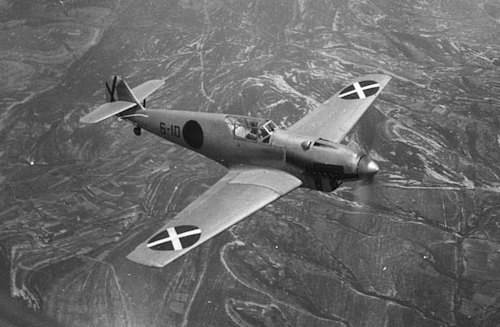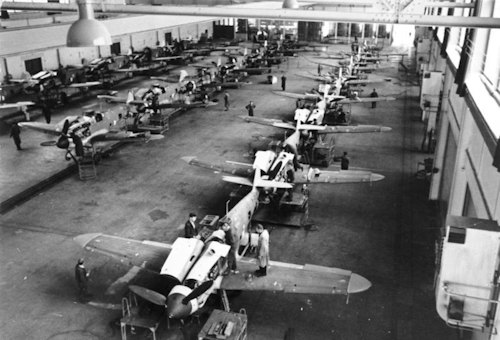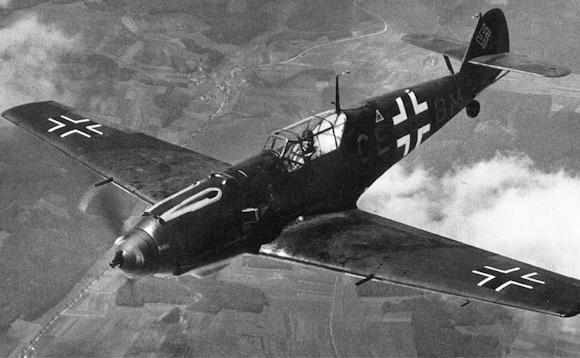The Messerschmitt Bf 109 it was absolutely one of the most important fighters in the Second World War, and the most famous of the Luftwaffe.
The aircraft was conceived and designed by Willy Messerschmitt and Robert Lusser. The first prototype (Bf 109 V1) took off for the first time in May 1935 near Augusta, and was piloted by Hans-Dietrich “Bubi” Knoetzsch; entered active service in the winter of 1937.
It should be noted that the German fighter was built in countless subseries and variants, and overall - from 1936 to 1945 - more than 34000 specimens were produced.
After the war, the aircraft continued to be built in Czechoslovakia as Avia S-99 and Avia S-199, and in Spain as Hispano Aviaciòn Ha-1109 and Ha-1112 (the Spanish Air Force used the aircraft until 1965).
The baptism of fire for German fighters occurred in the Spanish Civil War (1936-39). As regards the operational use of the aircraft in Spain (following photo) I refer to one of mine previous article.
Later, i Messerschmitt Bf109 took part in the invasion of Poland (September-October 1939), at battle of France (May-June 1940) and to battle of england (July-October 1940).
It is good to remember that the Bf 109 it had a maximum speed of over 550 km/h, and also a remarkable rate of climb which gave them an advantage over the fighters of the Royal Air Force.

One of the main advantages of the German fighter in aerial combat was the injection engine which allowed maneuvers at negative "g" (gli Spitfire The carburettor had to keep "g" positive in order not to run into "carburation gaps" and consequent "idle shots" of the engine and "stopping". To maintain engine power and positive acceleration, the pilots had to "break" the negative g maneuvers with half rolls, while the BF 109s could continue the negative g maneuver and gain advantage).
However, Luftwaffe fighters were less maneuverable than the Spitfire and in air battles all this represented a significant problem. What's more, unlike British fighters, many lacked armored pilot cockpits when the campaign began, despite having the bulletproof fuel tanks that fighters of "His Majesty" but they did not possess.1 In addition, i Messerschmitt Bf109 they were complicated to maneuver during take-off and landing, and had a rather "fragile" undercarriage.
In my opinion, it is interesting to establish what was the ratio of forces in terms of armament between the fighters of the Royal Air Force Bf 109. In this respect, the Hawker Hurricane and Supermarine Spitfire they were armed - at that stage - only with machine guns and were fixed in the front part of the wings. The machine guns were the American ones Browning, and were chosen because they provided a sufficiently safe operation to allow remote control and obviously the high shooting capacity (about 1260 rounds per minute). German fighters, on the other hand, were equipped with fixed machine guns in the cowling and 20 mm cannons in the wings. The latter were developed after the experiences learned in the war in Spain. In fact, in that conflict i Bf 109 they were very busy.

It should be emphasized that according to the German aviation ace Adolf Galland the most valid armament was that of the Messerschmitt Bf109 compared to Royal Air Force fighter armaments.2
Il Bf 109, during the Second World War, it was used in practically all war theaters: in the Mediterranean, in North Africa, on the Eastern front and in Italy. Up to the last i Messerschmitt Bf109 they defended the European territories occupied by the Wehrmacht's ground forces.
Eventually, during the war the aircraft was "outdated" by the Focke-Wulf Fw190.
Il Messerschmitt Bf109 (Bf 109 G6) had a wingspan of 9,925 m, length 8,95 m and height 2,6 m. The empty weight was 2247 kg, while loaded 3148 kg.
Engine: 1 Daimler-Benz DB 605, power 1475 HP. The maximum speed was 622 km/h at 8000 m, while the cruising speed was 590 km/h at 6000 m. The service ceiling was 12.000 m.
Armament consisted of 131 mm MG 13 machine guns, 151 mm MG 20 cannons or 108 mm MK 30 cannons. In addition, it consisted of Werfer-Granate 21 rocket launchers.
Bombs: 1 x 250 kg or 4 x 50 kg or 1 x 300 liter drop tank.
1 See BH Liddell Hart, Military history of World War II. Armies, fronts and battles, Mondadori, Milan, 2021, p.123
2 See Ibidem, p.125
Photo: web / Bundesarchiv












